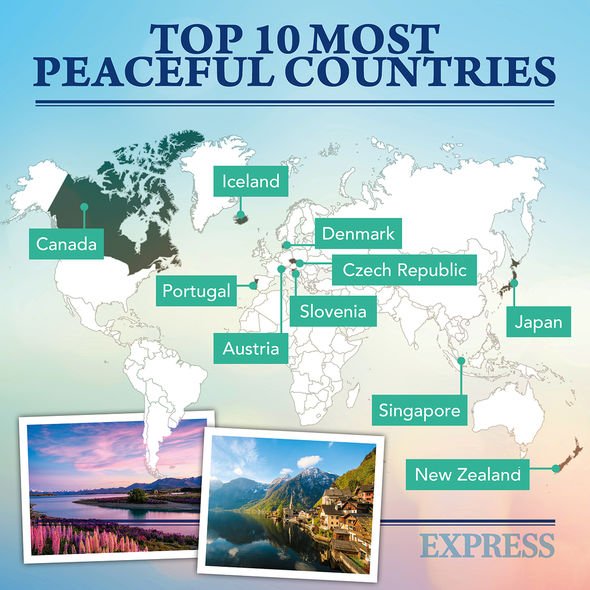Every year, the Institute for Economics and Peace (IEP) compiles the Global Peace Index, which is designed to show the peace performance of 163 countries. According to the 2020 ranking, the situation in the world as a whole has worsened.
The results at a glance.
What’s the world like? Where is it peaceful, where are there crises and where are there currently military conflicts and war? The Global Peace Index (GPI), which the Institute for Economics and Peace (IEP) has been publishing since 2007, attempts to answer these questions and provides an overview of the state of the world.
How is the “peaceableness” of a country measured?
On the basis of 23 qualitative and quantitative indicators, three broad areas are examined: “The level of social security, the extent of ongoing national and international conflicts, and the degree of militarization,” as the GPI states. This results in a score for each country. The lower this score is, the more peaceful a country is classified and the higher its position in the ranking.
Pillars of peace or peaceableness include solid institutions, a well-functioning government, freedom of the press, low corruption rates and a business-enhancing environment.
Corona pandemic affects world peace
While the 2019 Report had shown a slight improvement on 2018, the situation in the 2020 Global Peace Index has worsened. This is also due to the tensions and uncertainty caused by the Corona pandemic.
Because of the new situation, the report includes an analysis of the effects of the corona pandemic on world peace in addition to the results of the Global Peace Index 2020 this year. This includes an examination of positive characteristics such as “the attitudes, institutions and structures that create and maintain peaceful societies”. It also examines how the consequences of the crisis, especially the economic consequences, will affect the maintenance of peace in the coming years and which countries will recover best.
For example, it is assumed that civil unrest in Europe will increase and that the African continent will be increasingly burdened by famine. Furthermore, the Institute for Economics and Peace assumes that the more peaceful countries, where peace pillars such as a functioning government and a sound business environment are in place, will recover from the crisis more quickly than those countries whose situation was already difficult before the crisis. However, the full extent and long-term effects of the pandemic on world peace could not be determined at this stage.
The key findings of the Global Peace Index 2020:
* Iceland, which has no army of its own, retains its status as the most peaceful country on earth. The country has held this position since 2008.
* The top five are followed by New Zealand, Austria, Portugal and Denmark.
* Europe remains the most peaceful region on earth in 2020, although there has been a slight decline. 13 European countries are in the top 20 and only two European countries are not in the top half of the overall ranking.
* The Middle East and North Africa remain the regions most affected by conflict and violence worldwide.
* For the second year in a row, civil war-torn Afghanistan is the world’s least peaceful nation. Followed by Syria, Iraq, Southern Sudan and Yemen. With the exception of Yemen, all four have been among the least peaceful nations in the world since 2015.
* According to the GPI 2020, two out of nine regions have become more peaceful: Russia and Eurasia (which are considered as one region) and North America. The greatest improvements are seen in Russia and Eurasia, where there has been progress on security and ongoing conflict; , North America has improved in all three major areas.
* Germany’s position is also better than last year: the country rose from 22nd place last year to 16th place in 2020, bringing it back into the top 20.
* South and Central America and the Caribbean show the greatest regional deterioration. In South America, both the security situation and the degree of militarization have worsened. In Central America and the Caribbean, ongoing conflicts threaten regional peace.
* Terrorism and internal conflicts continue to be a major threat to peace worldwide.
* The number of civil unrest has risen by 282 percent since 2011, and the number of general strikes has increased by as much as 821 percent. In Europe, this period saw the highest number of protests, unrest and strikes. In sub-Saharan Africa, civil unrest increased by more than 800 percent.
* Overall, the world in 2020 is less peaceful than in the previous year. On average, countries have deteriorated by 0.34 percent, with 81 countries becoming more peaceful and 80 more unpeaceful. This is the ninth deterioration of peace in twelve years.
The 20 most peaceful countries in 2020
1. Iceland
2. new Zealand
3. Portugal
4. Austria
5. Denmark
6. canada
7th Singapore
8. the Czech Republic
9th Japan
10. switzerland
11. Slovenia
12. Ireland
13. Australia
14. Finland
15. sweden
16th Germany
17. Belgium
17. Norway (same score as Belgium)
19th Bhutan
20th Malaysia
Hector Pascua – Source: https://www.travelbook.de/orte/gefaehrliche-orte/travel-risk-map-gesundheit-verkehr-gefahren-unsichere-laender-reiseziele
This post has already been read 1552 times!



